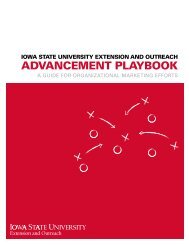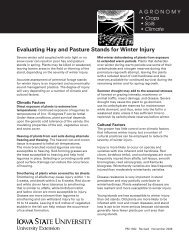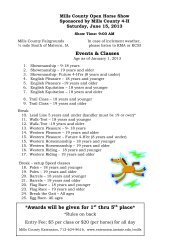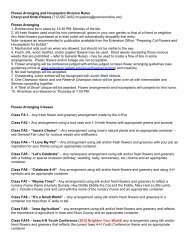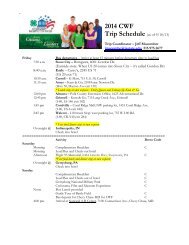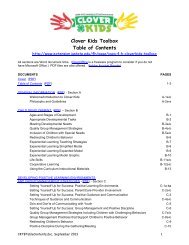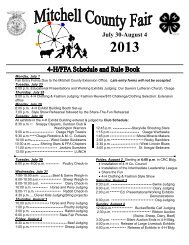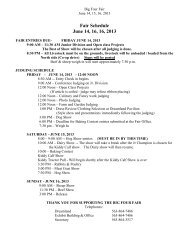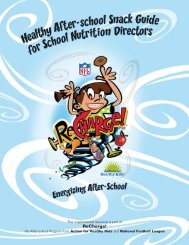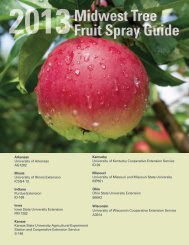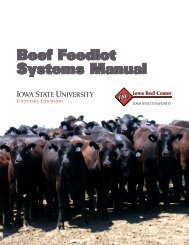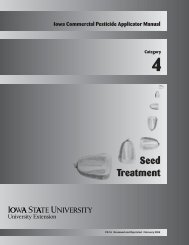Intercropping Winter Cereal Grains and Red Clover - Iowa State ...
Intercropping Winter Cereal Grains and Red Clover - Iowa State ...
Intercropping Winter Cereal Grains and Red Clover - Iowa State ...
Create successful ePaper yourself
Turn your PDF publications into a flip-book with our unique Google optimized e-Paper software.
<strong>Intercropping</strong><br />
<strong>Winter</strong> <strong>Cereal</strong> <strong>Grains</strong><br />
<strong>and</strong> <strong>Red</strong> <strong>Clover</strong><br />
University Extension<br />
PM 2025 May 2006
<strong>Intercropping</strong><br />
<strong>Winter</strong> <strong>Cereal</strong> <strong>Grains</strong><br />
<strong>and</strong> <strong>Red</strong> <strong>Clover</strong><br />
Introduction<br />
Energy, economic, environmental, <strong>and</strong> pest issues are<br />
leading some crop producers to diversity beyond the<br />
corn/soybean rotation dominant in <strong>Iowa</strong>. Research by<br />
<strong>Iowa</strong> <strong>State</strong> University <strong>and</strong> the United <strong>State</strong>s Department<br />
of Agriculture’s National Soil Tilth Laboratory indicates<br />
intercropping of winter cereal grains, such as wheat<br />
<strong>and</strong> triticale, with red clover is a promising option for<br />
producers wanting to exp<strong>and</strong> their crop rotation. This<br />
system can provide a hedge against weather extremes,<br />
disease <strong>and</strong> insect outbreaks, <strong>and</strong> high production costs.<br />
It provides better distribution of labor <strong>and</strong> equipment,<br />
price risk reduction, improved cash fl ow, <strong>and</strong> signifi cant<br />
additional income if straw is marketed. <strong>Red</strong> clover, as a<br />
soil-building green manure crop, can signifi cantly reduce<br />
nitrogen fertilizer needs. It also can provide multiple years<br />
of high-value forage.<br />
Benefi ts of this system<br />
Long-term yields <strong>and</strong> prices in <strong>Iowa</strong> <strong>and</strong> surrounding<br />
states indicate winter wheat returns $30 to $40 more<br />
revenue per acre than barley or oat. <strong>Winter</strong> triticale <strong>and</strong><br />
wheat are excellent feed for animal fi nishing diets. They<br />
are higher in lysine than corn <strong>and</strong> contain more energy<br />
per pound than barley or oat. Straw yields of winter cereal<br />
grains are equal to or greater than most spring cereal grains.<br />
As a legume, red clover is capable of biologically fi xing<br />
atmospheric nitrogen, which makes it a valuable source of<br />
nitrogen for subsequent crops. <strong>Cereal</strong> grain crops, such as<br />
corn, barley, oat, triticale, <strong>and</strong> wheat can follow red clover<br />
to take advantage of this nitrogen contribution. Research<br />
fi ndings indicate the average fertilizer nitrogen replacement<br />
value of red clover for a subsequent corn crop is<br />
about 80 lbs/acre. A good red clover st<strong>and</strong> provides up<br />
to four years of high quality forage. Animal performance<br />
from red clover can be as high as, or higher than, alfalfa.<br />
<strong>Winter</strong> cereal grain/red clover intercrops conserve natural<br />
resources. They protect soil because it is only vulnerable<br />
to erosion for a short period during cereal establishment.<br />
<strong>Winter</strong> cereals planted in the fall accumulate excess<br />
nutrients not used during growth of the previous crop <strong>and</strong><br />
use soil water that could otherwise contribute to nitrate<br />
leaching. Planting cereal grains after soybean requires<br />
little to no tillage, which preserves soil organic matter.<br />
Furthermore, winter cereals growing in the northern U.S.<br />
rarely need herbicides for weed control. <strong>Winter</strong> cereal<br />
production with a legume intercrop can increase soil<br />
carbon, which can lead to increased soil organic matter<br />
<strong>and</strong> better soil structure.<br />
<strong>Winter</strong> cereal grains <strong>and</strong> red clover are excellent crops for<br />
suppression of several persistent, soil-borne pests of corn<br />
<strong>and</strong> soybean. Multiple studies have documented the effectiveness<br />
of red clover to suppress corn rootworm, soybean<br />
cyst nematode, <strong>and</strong> weeds. Research from Minnesota has<br />
documented better suppression of soybean cyst nematode<br />
by non-host legume crops, such as red clover, than from<br />
corn. Research in <strong>Iowa</strong> found a three-fold reduction in<br />
weed density for red clover intercropped into winter cereal<br />
grains compared to fallow after winter cereal grains.<br />
Long-term yields <strong>and</strong> prices in <strong>Iowa</strong> <strong>and</strong> surrounding states<br />
indicate winter wheat returns $30 to $40 more revenue per acre<br />
than barley or oat.
Best Management Practices<br />
for <strong>Winter</strong> <strong>Cereal</strong> <strong>Grains</strong><br />
The main considerations for successful winter cereal grain<br />
production include site selection, fi eld history, soil fertility,<br />
variety selection, seeding rate, planting date, disease<br />
management, <strong>and</strong> harvest techniques.<br />
A well-drained site without soil compaction is best. Soybean<br />
is a good previous crop because it is harvested early<br />
enough for timely winter cereal grain planting, supplies a<br />
good seedbed for no-tillage seeding, <strong>and</strong> supplies residual<br />
nitrogen to the winter cereal grain. <strong>Iowa</strong> <strong>State</strong> University<br />
research has found that grain yield of winter cereals can<br />
be as much as 25 percent lower when corn silage was the<br />
previous crop compared to soybean. The site should be<br />
free of herbicide residues that could carry over <strong>and</strong> injure<br />
the cereal grain or red clover. Consult herbicide labels<br />
for intervals between product application <strong>and</strong> planting<br />
of winter cereals <strong>and</strong> red clover. Adjust the combine to<br />
spread residue evenly during harvest of the previous crop.<br />
This will aid subsequent planting operations <strong>and</strong> evenly<br />
distribute nutrients released from the crop residue.<br />
Phosphorus, potassium, <strong>and</strong> lime should be applied<br />
before planting. Application rates for these materials<br />
should be based on soil test analysis <strong>and</strong> consultation<br />
of the <strong>Iowa</strong> <strong>State</strong> University Extension Publication PM<br />
1688 “A General Guide for Crop Nutrient <strong>and</strong> Limestone<br />
Recommendations in <strong>Iowa</strong>.”<br />
To maximize grain production in <strong>Iowa</strong>, winter cereal<br />
grains should be topdressed with 30 lbs of nitrogen per<br />
acre in early- to mid-March when the crop begins spring<br />
green-up. Delaying application of nitrogen to the jointing<br />
(stem elongation) or later stages has little impact on yield.<br />
Excessive nitrogen fertilization of winter cereal grains is as<br />
much a problem in <strong>Iowa</strong> as under fertilization. Excessive<br />
nitrogen fertility causes lodging, resulting<br />
in uneven crop maturation, harvest<br />
losses, <strong>and</strong> smothering of red clover<br />
seedlings. Manure should be applied<br />
sparingly before or during winter cereal<br />
grain production.<br />
Use the most current performance<br />
test information for variety selection.<br />
<strong>Winter</strong> cereal grain variety performance<br />
for <strong>Iowa</strong> is contained in the ISU Extension<br />
Publication AG 6 “<strong>Iowa</strong> Crop<br />
Performance Tests - <strong>Winter</strong> Wheat<br />
<strong>and</strong> <strong>Winter</strong> Triticale.” Using old or<br />
unknown genetics often leads to poor results. Select cereal<br />
grain varieties with high disease <strong>and</strong> ergot resistance.<br />
Plant winter cereal grains before October 5 to achieve<br />
maximum grain yields in <strong>Iowa</strong>. Generally, this requires<br />
planting within a day or two after soybean harvest. Grain<br />
yields will be about 20 percent less if planting is delayed to<br />
October 15. Planting after October 15 is not recommended<br />
in <strong>Iowa</strong>. Optimum seeding rates are 30 seeds per sq. ft.<br />
(~100 lbs/acre) when planting before October 5. Increasing<br />
seeding rate to 40 seeds per sq. ft when planting after<br />
October 5 can offset yield reductions from late planting.<br />
Recent <strong>Iowa</strong> <strong>State</strong> University research has determined<br />
use of cereal grain seeding rates that optimize grain yield<br />
does not signifi cantly reduce red clover establishment <strong>and</strong><br />
productivity.<br />
Research <strong>and</strong> experience suggest no-tillage is a good<br />
strategy in <strong>Iowa</strong>. If no-tillage is selected, use a drill suitable<br />
for these conditions. Adjust the drill to ensure proper<br />
soil penetration, seed placement, <strong>and</strong> furrow closure. Drill<br />
in rows spaced 8 inches apart or less <strong>and</strong> at a depth of 1 to<br />
1.5 inches below the soil surface.<br />
<strong>Iowa</strong> <strong>State</strong> University research has determined use of cereal grain seeding<br />
rates that optimize grain yield does not signifi cantly reduce red clover<br />
establishment <strong>and</strong> productivity.
Weeds <strong>and</strong> insects are typically not a problem in winter<br />
cereal grains in <strong>Iowa</strong>. Diseases are a sporadic, although<br />
signifi cant problem, <strong>and</strong> are a limitation to growing<br />
winter cereal grains in <strong>Iowa</strong>. Fusarium (scab), septoria,<br />
<strong>and</strong> rusts are most common <strong>and</strong> serious outbreaks of<br />
these diseases occur in about 1 out of 5 years. <strong>Winter</strong><br />
cereal grains in <strong>Iowa</strong> also have been affected by tan spot,<br />
helminthosporium, <strong>and</strong> barley yellow dwarf virus. Grain<br />
infested with scab has a chalky appearance. It can cause<br />
problems when fed to livestock, especially swine, <strong>and</strong><br />
should be tested for mycotoxins. Non-breeding cattle<br />
<strong>and</strong> poultry tolerate scab-infested grain. Fungicides are<br />
available for managing fungal diseases in winter cereal<br />
grains. Effi cacy of these materials varies with disease<br />
<strong>and</strong> product.<br />
<strong>Winter</strong> cereal grains should be 13 percent moisture or<br />
less for safe storage. This can typically be achieved by<br />
fi eld drying a st<strong>and</strong>ing crop in <strong>Iowa</strong>. Because the grain<br />
is harvested when temperatures are warm, the grain will<br />
quickly spoil if not stored at a safe moisture content.<br />
Closely follow combine manufacturer settings to reduce<br />
harvest losses. Triticale grain can be more diffi cult to<br />
thresh from the spike than wheat grain, which may<br />
require additional monitoring during harvest. The<br />
winter cereal grain should be cut at a 6 to 8 inch height<br />
to avoid excess removal of red clover stem <strong>and</strong> leaves.<br />
This will allow rapid continuation of red clover growth.<br />
To avoid smothering red clover plants, straw should<br />
be shredded <strong>and</strong> evenly distributed across the fi eld or<br />
removed from the fi eld within a day or two after cereal<br />
grain harvest.
Best Management<br />
Practices for <strong>Red</strong> <strong>Clover</strong><br />
<strong>Iowa</strong> <strong>State</strong> University <strong>and</strong> National Soil Tilth Laboratory<br />
research has demonstrated frost seeding into winter cereal<br />
grains is a successful method for establishing red clover<br />
in <strong>Iowa</strong>. Profi table red clover production dem<strong>and</strong>s proper<br />
attention to site selection, soil fertility, variety selection,<br />
seed inoculation, <strong>and</strong> seeding rate.<br />
While red clover is more tolerant to poorly drained soils<br />
than alfalfa, soils saturated for extended periods should<br />
be avoided. <strong>Red</strong> clover is susceptible to drought <strong>and</strong> will<br />
not persist in s<strong>and</strong>y soils. Soil should be free of herbicide<br />
residues. Fertilizer should be applied to soils testing low<br />
or very low in phosphorus or potassium. If red clover is<br />
harvested as forage, fertilizer applications should account<br />
for nutrient removal rates as well. A soil pH above 6.0 is<br />
optimum for red clover. Consult <strong>Iowa</strong> <strong>State</strong> University<br />
Extension Publication PM 1688 “A General Guide for<br />
Crop Nutrient <strong>and</strong> Limestone Recommendations in <strong>Iowa</strong>”<br />
for lime, phosphorus, <strong>and</strong> potassium application rates.<br />
<strong>Red</strong> clover variety selection should be based on yield <strong>and</strong><br />
quality. The ISU Extension Publication AG 84 “<strong>Iowa</strong> Crop<br />
Performance Tests -- Alfalfa <strong>and</strong> Other Forages” contains<br />
red clover variety selection information. In addition, the<br />
University of Wisconsin has an extensive red clover variety<br />
testing program. Avoid purchase of unknown genetics,<br />
such as seed labeled as “variety not stated,” “common,”<br />
or “medium” red clover. Seed should be inoculated with<br />
Rhizobium bacteria to facilitate nitrogen fi xation.<br />
<strong>Red</strong> clover should be frost seeded at 15 to 20 lbs. per acre.<br />
Seeding rates above these levels increase forage yields<br />
slightly, but are not economically justifi ed. Frost seeding is<br />
best performed when the ground is frozen, usually in late<br />
February or March, by simply broadcasting seed on the<br />
soil surface. Ensuring the ground is frozen will minimize<br />
the effects of wheel traffi c on the small grain plants.<br />
Most importantly, the freezing <strong>and</strong> thawing of the soil, in<br />
addition to spring precipitation, creates good seed-to-soil<br />
contact for successful germination <strong>and</strong> st<strong>and</strong> establishment.<br />
No other incorporation methods are used <strong>and</strong><br />
successful establishment has been found in winter cereal<br />
grain st<strong>and</strong>s planted in both tilled <strong>and</strong> non-tilled soils.<br />
Most seed <strong>and</strong> fertilizer spreaders are suitable for frost<br />
seeding. Frost seeding can be done simultaneously with<br />
application of dry fertilizer. Combining frost seeding <strong>and</strong><br />
nitrogen fertilizer application in one operation will reduce<br />
fi eld traffi c <strong>and</strong> costs. The red clover requires no additional<br />
management until after cereal grain harvest in mid-July.
Management of <strong>Red</strong> <strong>Clover</strong><br />
as a Green Manure<br />
Multiple research studies indicate cropping systems<br />
relying on nitrogen supplied by red clover have been equal<br />
or greater in profi tability than systems using synthetic<br />
nitrogen fertilizers. Average fertilizer nitrogen replacement<br />
value of red clover for a subsequent corn crop is 80 lbs per<br />
acre. The yield response to nitrogen supplied by red clover<br />
is more variable than synthetic fertilizers. No replacement<br />
to complete replacement has been reported under various<br />
conditions. Precipitation, temperature, soil productivity,<br />
tillage, <strong>and</strong> other climate <strong>and</strong> soil factors can affect the<br />
amount of red clover nitrogen accumulated <strong>and</strong> availability<br />
to the succeeding crop.<br />
Late-spring soil nitrate (NO 3 -N) tests in corn following<br />
red clover may be used to determine if additional nitrogen<br />
fertilizer should be sidedressed. This approach appears<br />
most promising for fall-killed red clover. These tests may<br />
underestimate the nitrogen contribution from springkilled<br />
red clover. Consult ISU Extension Publication PM<br />
1714 “Nitrogen Fertilizer Recommendations for Corn in<br />
<strong>Iowa</strong>” for use of a soil nitrate test for nitrogen application<br />
in corn.<br />
There are many options for managing red clover as a<br />
green manure crop, including tillage <strong>and</strong> chemical control<br />
in both fall <strong>and</strong> spring. Plowing red clover provides about<br />
two times more nitrogen to a subsequent corn crop as<br />
chemical control. Zone tillage of clay loam soil following<br />
red clover has produced corn yields similar to conventional<br />
tillage. The high nitrogen content of red clover residue<br />
accelerates the decomposition of cereal crop residue.<br />
There are several advantages associated with autumn<br />
chemical kill of red clover before planting no-tillage corn,<br />
including earlier planting dates, warmer soil conditions,<br />
reduced risk of dry seedbed conditions, <strong>and</strong> reduced<br />
likelihood of clover competition with early corn growth.<br />
<strong>Red</strong> clover residues decompose rapidly after spring kill<br />
with half of the nitrogen released within 4 weeks after<br />
burial <strong>and</strong> very little nitrogen released after 10 weeks.<br />
When red clover is killed before planting, nitrogen is<br />
released from residue in synchrony with the nitrogen<br />
uptake pattern of corn. Delaying kill of red clover from<br />
fall until spring does not increase nitrogen availability.<br />
Killing red clover in the fall or early spring can be effective<br />
for limiting soil water loss without sacrifi cing benefi ts to a<br />
subsequent crop.<br />
<strong>Red</strong> <strong>Clover</strong><br />
Forage Management<br />
<strong>Red</strong> clover can be used as forage for one to four years.<br />
In a one year system, it is possible to obtain two red<br />
clover harvests. The fi rst cutting should be taken when<br />
10 percent of the clover plants are in bloom. The second<br />
cutting should be made before a killing frost in early<br />
October. A harvest in early May before corn planting also<br />
can be obtained if desired. The red clover yields in Table<br />
1 were obtained near Ames, <strong>Iowa</strong> with two cuttings in the<br />
establishment year <strong>and</strong> a third cutting in the following<br />
spring. These results were collected from a year with ideal<br />
conditions for red clover growth <strong>and</strong> another year with<br />
below-average rainfall in July <strong>and</strong> August.
Establishment Spring following<br />
year1 establishment2 <strong>Red</strong> clover<br />
seeding rate Average Range Average Range<br />
lbs/acre tons per acre (15% moisture) 3<br />
5 1.8 1.3 – 2.3 1.4 1.2 – 1.5<br />
10 2.3 1.6 – 2.9 1.4 1.3 – 1.5<br />
15 2.3 1.7 – 2.8 1.5 1.2 – 1.8<br />
20 2.3 1.5 – 3.1 1.6 1.5 – 1.6<br />
25 2.6 1.9 – 3.2 1.4 1.2 – 1.6<br />
1 Combined yield of two cuttings – average harvest dates were August 22 <strong>and</strong> October 3.<br />
2 Single cutting – average harvest date of May 10.<br />
3 Average yield of red clover established in wheat or triticale.<br />
Table 1. Forage yield of red clover frost seeded into winter cereal grains<br />
in 2003 <strong>and</strong> 2004 near Ames, <strong>Iowa</strong>.<br />
When red clover will be grown for two or more years, the<br />
fi rst hay cutting in the seeding year should be taken when<br />
10 percent of clover plants are in bloom, but the last summer<br />
cut should be made by September 1 to 15. Cuttings<br />
in the second <strong>and</strong> third years also should be timed when<br />
10 percent of the clover plants are in bloom. The fi rst<br />
spring cutting will occur in late May or early June. Fields<br />
in the southern part of the state will reach this maturity in<br />
the spring about a week earlier than in northern counties.<br />
Cutting at the 10 percent bloom stage will provide<br />
three cuttings per year. If summer rainfall is good, clover<br />
cuttings can be taken about every 35 to 42 days.<br />
If the st<strong>and</strong> will be maintained the following year, it<br />
is important to give the plants about 45 days between<br />
the last cutting <strong>and</strong> freeze-down, which occurs about<br />
mid-October. An additional harvest (or grazing) can be<br />
made after freeze-down, but the forage is diffi cult to dry<br />
thoroughly for dry hay storage. If summer weather is hot<br />
<strong>and</strong> dry, clover growth may almost stop, <strong>and</strong> sometimes<br />
very short plants will start to bloom. It may be impractical<br />
to cut these short plants for hay.<br />
Quality <strong>and</strong> animal performance from red clover ranks<br />
high among forages <strong>and</strong> can be as high as, or higher than<br />
that of alfalfa. Preservation of green color during fi eld drying<br />
is more diffi cult with red clover than other legumes,<br />
so red clover hay often appears to be of poor<br />
quality when it’s not. <strong>Red</strong> clover quality does not<br />
decline as rapidly with maturity as alfalfa quality.<br />
<strong>Red</strong> clover maintains its high forage quality until<br />
about 40 to 50 percent of the stems have blooms.<br />
This means a longer period over which high<br />
quality forage can be harvested. Even so, red clover<br />
often is not harvested soon enough, which results<br />
in poor regrowth <strong>and</strong> lower yields. When harvested<br />
as late as full bloom, new growth from the crown<br />
will have started to elongate. As these young shoots<br />
are removed during a delayed harvest, a sharp<br />
reduction in the next growth often occurs.<br />
<strong>Red</strong> clover is more diffi cult to dry for hay than<br />
alfalfa. It is very leafy <strong>and</strong> covered with short hairs,<br />
both factors affecting air circulation <strong>and</strong> drying in<br />
the windrows. These issues as well as leaf shatter<br />
<strong>and</strong> harvest losses can be reduced greatly by harvesting<br />
red clover as silage. Well managed red clover silage is<br />
palatable to livestock <strong>and</strong> is a very effi cient way to harvest <strong>and</strong><br />
retain the crop’s nutritive value. It can be ensiled successfully<br />
in upright <strong>and</strong> bunker silos, as well as in the increasingly popular<br />
silo bags <strong>and</strong> individually wrapped bale silage packages. For<br />
a good silage product, use good ensiling management practices,<br />
including harvest at 50 to 70 percent moisture, proper use of<br />
silage inoculants, <strong>and</strong> proper packing <strong>and</strong> sealing.<br />
When making dry hay, use of mechanical conditioning (rolling<br />
or crimping) <strong>and</strong> leaving the forage in wide swaths early in the<br />
drying period are recommended. Dried leaves shatter readily, so<br />
rake or manipulate windrows when the hay is greater than 40<br />
percent moisture to prevent excessive shatter losses. <strong>Red</strong> clover<br />
hay often is considered to be more dusty than other legume hay.<br />
If stored at improper moisture levels, it can heat excessively <strong>and</strong><br />
become moldy. Mold growth in red clover hay has been associated<br />
with excessive slobbering in horses. Therefore, red clover<br />
hay is less attractive to horse owners than other types of hay.<br />
A winter cereal grain <strong>and</strong> red clover intercrop can be used to lengthen<br />
crop rotations. This system has the potential to increase revenue<br />
relative to spring cereal grains while providing nitrogen for<br />
subsequent crops <strong>and</strong> high value forage. As with any cropping<br />
system, success of a winter cereal grain <strong>and</strong> red clover intercrop<br />
depends on careful management of the system components.<br />
Quality <strong>and</strong> animal performance from red clover ranks high among<br />
forages <strong>and</strong> can be as high as, or higher than that of alfalfa.
<strong>Intercropping</strong><br />
<strong>Winter</strong> <strong>Cereal</strong> <strong>Grains</strong><br />
<strong>and</strong> <strong>Red</strong> <strong>Clover</strong><br />
University Extension<br />
Prepared by:<br />
Lance Gibson, associate professor, department of agronomy<br />
Jeremy Singer, research agronomist, USDA-ARS National Soil Tilth Laboratory<br />
Stephen Barnhart, professor, department of agronomy<br />
Brock Blaser, graduate teaching assistant, department of agronomy.<br />
File: Agronomy 2 & 3<br />
. . . <strong>and</strong> justice for all<br />
The U.S. Department of Agriculture (USDA) prohibits discrimination in all its programs <strong>and</strong> activities on the basis of race, color, national origin,<br />
gender, religion, age, disability, political beliefs, sexual orientation, <strong>and</strong> marital or family status. (Not all prohibited bases apply to all programs.)<br />
Many materials can be made available in alternative formats for ADA clients. To fi le a complaint of discrimination, write USDA, Offi ce of Civil<br />
Rights, Room 326-W, Whitten Building, 14th <strong>and</strong> Independence Avenue, SW, Washington, DC 20250-9410 or call 202-720-5964.<br />
Issued in furtherance of Cooperative Extension work, Acts of May 8 <strong>and</strong> June 30, 1914, in cooperation with the U.S. Department of Agriculture.<br />
Jack M. Payne, director, Cooperative Extension Service, <strong>Iowa</strong> <strong>State</strong> University of Science <strong>and</strong> Technology, Ames, <strong>Iowa</strong>.



